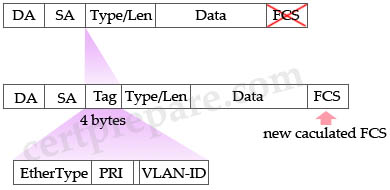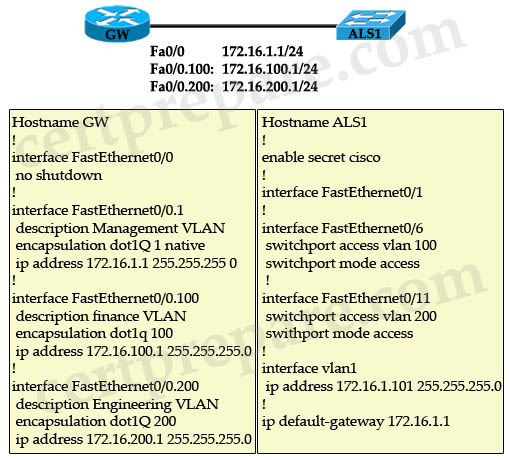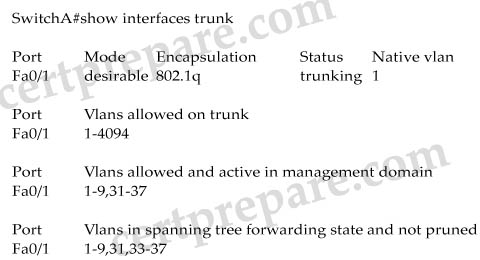VLAN Trunking Questions 2
Here you will find answers to VLAN Trunking Questions – Part 2
Question 1
You are the network administrator at Company and switch R1 is configured as shown below:
interface GigabitEthernet0/1
switchport mode trunk
switchport trunk encapsulation dot1q
switchport trunk native vlan 5
If untagged frames are arriving on interface GigabitEthernet0/1 of R1, which of the following statement are correct?
A. Untagged frames are automatically assumed to be in VLAN 5.
B. Untagged frames are defaulted to VLAN 1 traffic.
C. Untagged frames are dropped because all packets are tagged when dot1q trunked.
D. Untagged frames are determined on the other switch
E. Untagged frames are not supported on 802.1Q trunks.
Answer: A
Explanation
The “switchport trunk native vlan 5” sets VLAN 5 to be the native VLAN so traffic to this VLAN will be untagged. Also untagged traffic are automatically assumed to be in VLAN 5 -> A is correct.
Note: The native VLAN must match on both sides of the trunk link for 802.1Q; otherwise the link will not work.
Question 2
What are three results of issuing the “switchport host” command? (Choose three)
A. disables EtherChannel
B. enables port security
C. disables Cisco Discovery Protocol
D. enables PortFast
E. disables trunking
F. enables loopguard
Answer: A D E
Explanation
Catalyst 6500 switches running Cisco IOS software support the macro command switchport host. The switchport host macro command was designed to facilitate the configuration of switch ports that connect to end stations. Entering this command sets the switch port mode to access, enables spanning tree PortFast, and disables channel grouping, all at the same time. The switchport host macro command can be used as an alternative to the switchport mode access command.
(Reference: http://www.cisco.com/en/US/docs/solutions/Enterprise/Security/Baseline_Security/sec_chap7.html)
Question 3
If you were to configure an ISL Ethernet trunk between two Cisco switches, named R1 and R2, what would you have to include at the end of the link for the trunk to operate correctly? (Choose two)
A. An identical VTP mode.
B. An identical speed/duplex.
C. An identical trunk negotiation parameter.
D. An identical trunk encapsulation parameter.
Answer: B D
Explanation
One of the requirements for trunking to work is for speed and duplex to be the same on both sides. -> B is correct.
Maybe answer D wants to mention about encapsulation type (ISL or 802.1q) so it is an acceptable answer.
(Reference: http://www.cisco.com/en/US/products/hw/switches/ps663/products_configuration_example09186a008014859e.shtml)
Question 4
Which three statements are correct with regard to the IEEE 802.1Q standard? (Choose three)
A. The IEEE 802.1Q frame format adds a 4 byte field to a Ethernet frame
B. The packet is encapsulated with a 26 byte header and a 4 byte FCS
C. The protocol uses point-to-multipoint connectivity
D. The protocol uses point-to-point connectivity
E. The IEEE 802.1Q frame uses multicast destination of 0x01-00-0c-00-00
F. The IEEE 802.1Q frame retains the original MAC destination address
Answer: A D F
Explanation
There are two ways to implement Ethernet trunking:
* Inter-Switch Link Protocol (ISL, a Cisco proprietary protocol)
* 802.1Q (IEEE standard)
In Cisco implementation, a trunk is a point-to-point link, although it is possible to use the 802.1Q encapsulation on an Ethernet segment shared by more than two devices. Such a configuration is seldom needed but is still possible with the disablement of DTP negotiation -> D is correct.
IEEE 802.1Q uses an internal tagging mechanism which inserts a 4-byte tag field in the original Ethernet frame itself between the Source Address and Type/Length fields -> A is correct.

The SA field is the source address field of the ISL packet. It is a 48-bit value -> F is correct.
(Reference: http://www.cisco.com/en/US/products/hw/switches/ps700/products_tech_note09186a008012ecf3.shtml)
Question 5
Refer to the exhibit. Why are users from VLAN 100 unable to ping users on VLAN 200?

A. Encapsulation on the switch is wrong.
B. Trunking needs to be enabled on Fa0/1.
C. The native VLAN is wrong.
D. VLAN 1 needs the no shutdown command.
E. IP routing needs to be enabled on the switch.
Answer: B
Explanation
In this question, maybe the exhibit forgot to describe Fa0/1 is the port on the switch which is connected to the router. To allow interVLAN routing between VLAN 100 and 200, this port must be configured as trunk port.
If you wish to see the full configuration of interVLAN routing, please read my interVLAN routing tutorial (you will see the configuration at the bottom of that tutorial).
Question 6
What is the effect of applying the “switchport trunk encapsulation dot1q” command to a port on a Cisco Catalyst switch?
A. By default, native VLAN packets going out this port will be tagged.
B. Without an encapsulation command, 802.1Q will be the default encapsulation if DTP fails to negotiate a trunking protocol.
C. The interface will support the reception of tagged and untagged traffic.
D. If the device connected to this port is not 802.1Q-enabled, it will not be able to handle 802.1Q packets.
Answer: C
Explanation
The “switchport trunk encapsulation dot1q” command configures trunk encapsulation as 802.1q, which supports the reception of tagged and untagged traffic -> C is correct.
Note: If your switch does not accept this command, try to enter “switchport” command first to configure the interface as a Layer 2 port.
Question 7
Two Company switches are connected via a trunk link. In this network, the original frame is encapsulated and an additional header is added before the frame is carried over a trunk link. At the receiving end, the header is removed and the frame is forwarded to the assigned VLAN. This describes which technology?
A. DISL
B. ISL
C. DTP
D. IEEE 802.1Q
E. MPLS
Answer: B
Explanation
Unlike 8021.q, ISL keeps the original frame unchanged. It only adds another header to that frame before sending out over a trunk link. For more information about this difference, please read the explanations of Question 2 and Question 3 in the first VLAN Trunking Questions part.
Question 8
Which of the following trunking modes are unable to request their ports to convert their links into trunk links? (Choose two)
A. Negotiate
B. Designate
C. Nonegotiate
D. Auto
E. Manual
F. Off
Answer: C D
Explanation
The mode auto (dynamic auto) causes the device not to send DTP Request but wait for DTP Request from neighboring device.
By using and switchport mode trunk and switchport nonegotiate commands, we can enable trunking to a device that does not support DTP. But notice that the switchport nonegotiate command causes the device not to send DTP Request frames.
Therefore both “auto” and “nonegotiate” modes makes the switch not to send request (which is “unable to convert their links into trunk links”) -> C and D are correct.
Question 9

You administer the network shown above. You issue the show interfaces trunk command on SwitchA and receive the following output:

Which of the following statements is true regarding VLAN 32?
A. VLAN 32 is not allowed on the trunk port.
B. VLAN 32 is not active on the switch.
C. Traffic from VLAN 32 is not being sent over the trunk port.
D. Traffic from VLAN 32 is not restricted to only the trunk ports that require it.
Answer: C
Explanation
In the “Vlans in spanning tree forwarding state and not pruned” VLAN 32 is not listed so we can conclude it is not in forwarding state or it is pruned. But with the above topology STP cannot block any port so we can deduce it is pruned.
Question 10
Which statement is true regarding the configuration of ISL trunks?
A. A Catalyst switch cannot have ISL and IEEE 802.1q trunks enabled.
B. All Catalyst switches support ISL trunking.
C. A Catalyst switch will report giants if one side is configured for ISL while the other side is not.
D. ISL trunking requires that native VLANs match.
Answer: C
Explanation
First you should know “giant” frames are frames that exceed the maximum IEEE 802.3 frame size (usually greater then 1518 bytes). As you know, ISL does not modify the original Ethernet frame it received but it adds another outer header. In particular, it uses a 26 byte header and 4 byte FCS (30 bytes in total).
| ISL Header (26 bytes) |
Encapsulation Frame (Original Data) | FCS (4 bytes) |
But a normal Ethernet frame itself can have a maximum size of 1518 bytes. Therefore an Ethernet frame can be up to 1518 + 30 = 1548 bytes, which creates a “giant”.
That is why both ends must be configured as ISL trunks because only ISL-aware devices are able to read it.


